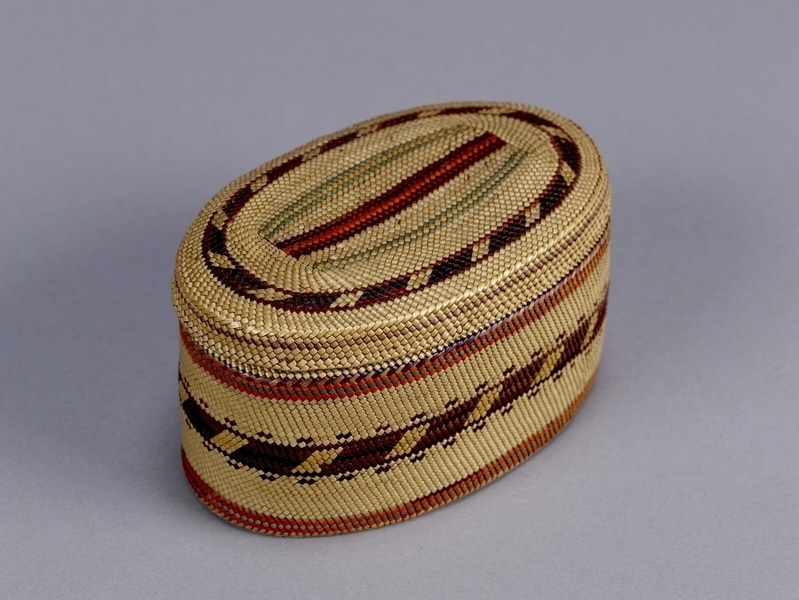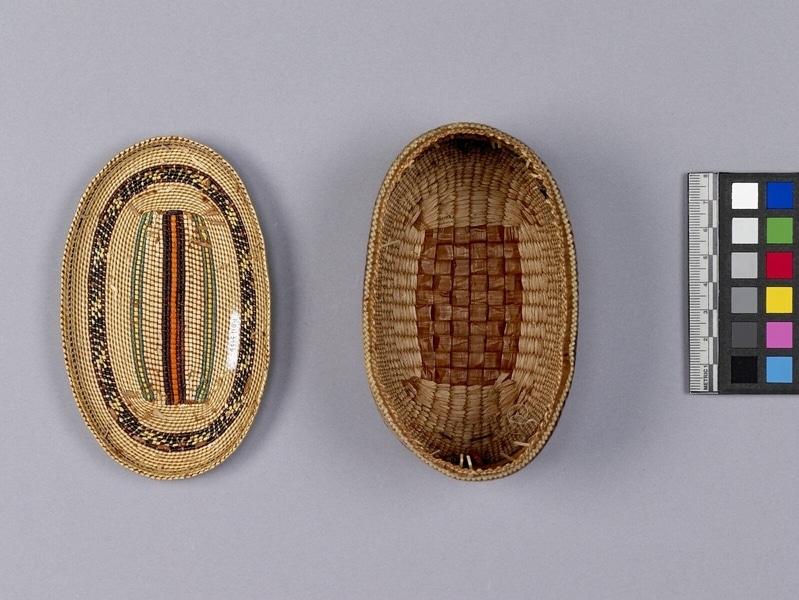Basket Item Number: Nb11.343 a-b from the MOA: University of British Columbia



Description
Oval, straight-sided basket (a) with a flat-topped, fitted lid (b). Sharp shoulder with reinforced cedar bark hoop rim, edged with a single row of grass twining. Cedar bark checker work foundation surrounded by grass twining of three different widths. Natural colour with small scale geometric designs. At mid-point of basket and on top of lid is dark purple and yellow band with diamond pattern. At shoulder and base of basket is band of purple, orange and green. At centre of lid top is horizontal band of purple and red surrounded by two curved lines of green and yellow. At rim of lid is thin band of faded purple. Twill twining at edge of basket.
History Of Use
Before European contact Nuu-chah-nulth baskets were predominately undecorated, all-purpose containers. Checkerwork bags and pouches were used for whaling and fishing gear. Finely woven baskets held liquids and were used to boil food by adding heated stones. By the mid-19th century, when missions and trading posts were well established on the Northwest Coast, the manufacture of functional basketry declined and the Nuu-chah-nulth began to make small decorated 'fancy' baskets for sale. These baskets are characterized by realistic and less frequently, geometric designs. Up to the 1890's Nuu-chah-nulth basketry is open wrapped twined, checkerwork and plain twilled. After this date most are close wrapped twined.
Cultural Context
made for sale
Item History
- Made in Vancouver Island, British Columbia, Canada before 1976
- Collected during 1900
- Owned by Dorothy Ladner and Edna Ladner before April 12, 1976
- Received from Dorothy Ladner (Donor) and Edna Ladner (Donor) on April 12, 1976
What
- Name
- Basket
- Identification Number
- Nb11.343 a-b
- Type of Item
- basket
- Material
- aniline dye ?, cedar bark, bear grass ? and grass
- Manufacturing Technique
- wrapped twined, twined, checkerwork and twill twined
- Overall
- height 6.5 cm, width 12.5 cm, depth 7.5 cm
Who
- Culture
- Nuu-chah-nulth
- Previous Owner
- Dorothy Ladner and Edna Ladner
- Received from
- Dorothy Ladner (Donor) and Edna Ladner (Donor)
Where
- Holding Institution
- MOA: University of British Columbia
- Made in
- Vancouver Island, British Columbia, Canada
When
- Creation Date
- before 1976
- Collection Date
- during 1900
- Ownership Date
- before April 12, 1976
- Acquisition Date
- on April 12, 1976
Other
- Item Classes
- basketry
- Condition
- good
- Current Location
- Case 9
- Accession Number
- 0299/0022